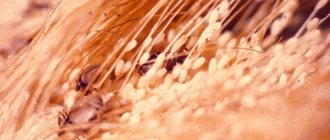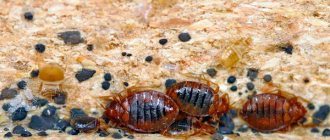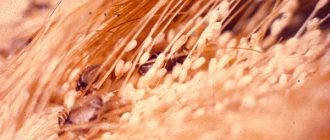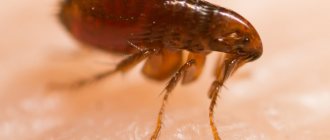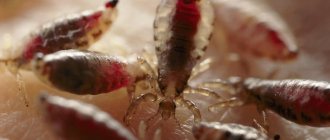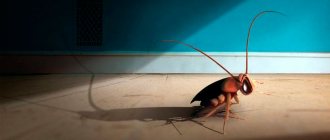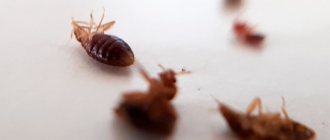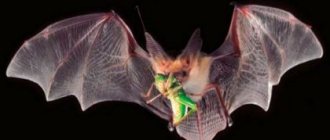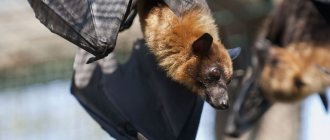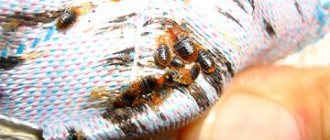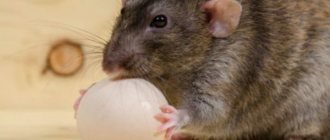- about the author
- VK profile
Svetlana Tarasova
Hairdresser-stylist with more than 8 years of experience, expert in the field of haircuts, styling, hair care, coloring.
Lice are blood-sucking parasites of the insect class. People are parasitized by 2 types of lice: human (includes two subspecies - head and body lice) and pubic. If a head or body louse has settled at the roots of the hair, the disease is called pediculosis. If pubic - phthiriasis. These diseases are transmitted only from a sick person to a healthy one. The disease is treated with medications and alternative medicine. There are effective methods of prevention.
Who are lice?
Lice are small bugs, up to 0.5 mm , that live in people's hair, such as on the scalp, eyelashes, eyebrows and pubic area. They are an insect with 6 legs and a gray or light brown body. Lice are very fast, but they cannot jump, like fleas.
The insect feeds on human blood through a special flagellum , so it chooses habitats with the thinnest skin to make it easier to suck the blood.
A fertilized louse lays thousands of nits during its 40-day life, which take approximately 14 days . Nits are attached at the roots of the hair and have a characteristic transparent white color.
What do they look like?
Linen lice, photos of which you see in our article, like their fellow species, have a rather inconspicuous appearance. The need to look as inconspicuous as possible makes these bed and body parasites very dexterous in solving camouflage issues. Getting rid of body lice at home can be quite difficult. First you need to figure out where they come from and what they look like. The description of their biological parameters looks succinct. These are insects with a translucent body, no more than 3 mm in length, the wingless body is elongated, and when saturated with blood it acquires a brownish-brown tint.
Larvae and nits are no more than half the size of an adult's body. Insects prefer to stay in groups; it is the massiveness of their colonization that usually allows us to detect the source of problems. At first glance at them, it may seem that small whitish grains are scattered on the surface of the fabric. But, taking a closer look and discovering the presence of paws, it is difficult to doubt the species of blood-sucking skin parasites.
Prevention measures
To protect a child from head lice and protect all other family members, it is necessary to take a set of measures:
- avoid large crowds of people in public places;
- collect hair in a tight bun or braid, use a headdress;
- do not use other people’s hygiene items;
- protect the child from communicating with children from disadvantaged families and strangers;
- regularly treat combs, combs, and hair accessories with soapy water.
To prevent lice, you can use essential oils, shampoos, and soaps with a scent that repels lice.
Causes of parasites
The occurrence of lice and nits is usually associated with poor personal hygiene. Most often, this disease accompanies people leading a vagabond lifestyle. Children from disadvantaged families also get lice quite often. Because of this, there are outbreaks of lice infections in kindergartens, schools and summer camps.
You can become infected with lice not only through close contact with a sick person. Lice are also transmitted as a result of using the personal belongings of an infected person:
- combs, combs;
- hair clips and elastic bands;
- hats;
- towels;
- bed sheets;
- cloth.
On a note!
Within two days, parasites can remain outside human skin and remain viable. And when they come into contact with the human body, they become active again.
Where do lice come from?
The only reason lice appear in people is the transfer of nits or a fully formed individual from another person . Most often, lice occur in children; even a newborn child can become infected with lice, for example, from his mother or the people around him. Children are more susceptible to diseases than adults, so lice is more dangerous for them than for others. The child does not understand the full danger of the disease, which can lead to some consequences:
- Sleep disturbance in a child
- The child cannot concentrate on anything because the itching in the head bothers him.
- Due to the constant itching, which the child cannot control and scratches his head without stopping, bloody and purulent wounds appear, which in the future can lead to infections and contracting dangerous diseases.
The main places of infection with pediculosis:
- School and kindergarten.
- Trains and planes.
- Swimming pools, saunas, concerts, with a huge audience.
Can lice appear on colored hair?
When there is a suspicion of lice infection, almost every representative of the fair half of humanity asks the question of whether lice get in colored hair?
Despite the fact that some paints contain components that have a negative effect on the body of parasites, lice can feel quite comfortable if the coloring procedure was carried out several days ago. Thus, the answer to the question of whether lice live on colored hair can only be positive.
Why don't lice live on painted ones?
Exceptions that exclude the possibility of lice include the regular use of aggressive dyes containing ammonia, perhydrol, and a number of others. On a head that is dyed at least once a week, lice may not appear.
However, dyeing so often is still not recommended, as curls and strands become brittle and dull. A strong, strong odor can repel lice. For example, seams do not sit on dyed hair directly during the dyeing procedure, as this may well cause their death.
Substances
Chemicals that have an adverse effect on lice are included in pharmaceutical preparations, these include:
- permethrin;
- malathion;
- phenothrin;
- dimethicone;
All of them have different effects on insects: some paralyze the nervous system, others corrode the chitinous shell, others have a suffocating effect, but ultimately lead to the rapid death of adult individuals.
The most effective and efficient way to remove lice is an integrated approach. When treating pediculosis, it is necessary not only to treat the head with a special product, but also to comb out the nits mechanically every day, using a comb.
For preventive purposes, in the summer, you should constantly inspect your head for lice and nits, since absolutely anyone can become infected with lice, regardless of their cleanliness.
Ways to combat pediculosis
If a person does become infected with parasites, it is necessary to get rid of lice as soon as possible. There are a large number of different means and methods for this. There are several types of effects on lice and nits:
- chemical using drugs containing toxic toxins and insecticides;
- temperature effects on lice using low and high temperatures;
- mechanical by combing hair out with special combs and combs;
- repelling parasites with strong-smelling substances containing natural ingredients and extracts.
How dangerous are lice?
Lice are not poisonous insects, but due to their rapid reproduction, they are still considered dangerous . Lice bites leave red spots on the skin and itching, accompanied by unpleasant sensations. With constant scratching of the bite sites, a purulent wound may form. Dirt from under the nails, dust and many other factors can get into the wound, which can subsequently lead to rotting of the entire head, infections and various dangerous diseases.
Not only do lice suck blood and reproduce at a tremendous rate, but they also transmit diseases such as typhus, typhus, typhus, and STDs, which can be seen through many symptoms.
Typhus is caused by bacteria that enter the bite wound along with louse feces. Accompanied by symptoms:
- Body temperature is more than 38.5.
- Feverish condition.
- Excessive nervousness.
- Eternal heart tingling and “grasping.”
- Rash all over the body, like chickenpox.
Typhus Tularemia – the main carrier of the disease is large animals, as well as dogs and cats, but lice can also spread the disease to people. Symptoms of the disease:
- High body temperature.
- Dizziness and fainting.
- Headache, which is accompanied by a sensation of “splitting” of the skull.
- Pain in fingers and toes, difficulty bending.
- Confused consciousness.
Tularemia
Living conditions
Linen lice are not only an unpleasant, but also quite dangerous phenomenon. How to get rid of parasites at home depends on their prevalence. Their main habitat is dirty clothes. But in order to receive nutrients for their vital functions, they need to periodically move onto the human body.
The problem is not only that lice suck blood. To reduce clotting and make it easier to obtain food, insects sprinkle a special enzyme under the skin of the victim. Because of it, a person experiences allergic reactions and spots appear on the skin.
It is known that linen lice can withstand a fairly wide temperature range. Adult parasites are able to exist at temperatures from 0 to 45 ° C. Larvae require slightly more comfortable conditions, from 5 to 40 ° C. But for active reproduction, a warm and dry environment is required, where the temperature is within 30 ° C
It is important to understand that when a person takes off his clothes, his temperature drops noticeably and the activity of the individuals slows down. High humidity has a beneficial effect on their body
Therefore, a sweating person is an ideal victim for them.
Why is it impossible to eradicate pediculosis?
The louse is a human ectoparasite that loves unsanitary conditions and crowds of people. The disease is widespread among the population of undeveloped countries and occurs in outbreaks throughout the world.
Dysfunctional families, people without a fixed place of residence, people leading a dissolute lifestyle are a source of infection. In such cells of society, the fight against pediculosis is not carried out at all, or it is done superficially. Lice continue to inhabit the planet, infect people, and annoy people with their existence.
On a note!
You can catch lice anywhere, through close contact with an infected person or his things. The opinion that lice love unsanitary conditions and choose dirty, unwashed heads is completely unfounded. Insects settle on a well-groomed head equally quickly and feel much more confident there.
Travelers, volunteers, children, and people who neglect basic personal safety rules are at risk.
Possibility of head lice from stress
There are many common theories about the appearance of lice from nerves. Speculation is widespread not only in the provinces, but also among the urban, educated population.
Let's look at the most common myths:
- During nervous stress, insects react to the sweat secreted by a person. Therefore, they appear on the scalp and begin to actively reproduce, feeding on human blood. While a person is calm emotionally, the lice lie dormant in the head without manifesting themselves. A person has no idea about the existence of insects until he starts to get nervous. At this point, lice become more active due to stress, causing itching and other symptoms of lice. If a person is nervous regularly, a lump appears on the head in which subcutaneous lice live. Lice can appear due to insufficient hygiene, if a person does not wash for a long time and is nervous. Lice are part of the body, appear under the influence of stressful situations and they die only in the event of a person’s death.
As you can see, theories about the appearance of lice on nerves are varied. A person who is faced with the problem of head lice should know that they are all completely groundless and illogical. Modern scientists have explored and thoroughly studied the possible ways in which parasites appear, and the above theories about how lice appear from nerves are not one of them.
What repels lice and what are they afraid of?
To get rid of lice, you need to use only products purchased at a pharmacy on the advice of a pharmacist. With some products you just need to wash your hair, some leave it on your head for 2-6 hours, wearing a medical cap, a swimming cap or a plastic bag on top. Products to be used:
- Medifox . Prepare a 0.2% solution of the drug: dilute 8 ml of the drug with 200 warm boiled water. Rub into areas of head lice infestation and leave for 20 minutes. Wash off with water and laundry soap.
- Foxylon . Apply lotion to clean hair, rubbing evenly into roots. Leave for 15 minutes and rinse with shampoo. Instead of regular rinse aid, use a solution of 4.5% acetic acid.
- Pedilin . In this case, emulsion and shampoo are used. Apply each product in turn for 10-15 minutes.
Also, lice are afraid not only of drugs, but also of various factors :
- Lice are afraid of strong odors ; essential oils can easily cope with the destruction of lice and their nits. The best oils are lavender, eucalyptus, tea tree, rosemary, orange and others. It is worth lubricating the areas behind the ears, the back of the head and 1 cm of the forehead located after the hairline. Also, adding a few drops of oils to your shampoo will also help.
- Hair dye . Any paint using essential oils, hydrogen peroxide or ammonia will also help get rid of lice, but this method will not help with nits.
- Frost or heat . In 40-degree frost, lice die after 30 minutes, and in 40-degree heat they begin to slow down. To get rid of lice, simply treat your hair with hot air from a hair dryer for 30 minutes.
- A haircut . During the war period, this method was used more often than all others. Shaving your head will help both from nits and from adult lice themselves.
- Lice hate birch tar , so washing your hair with tar soap will help kill the parasites.
- A solution of salt, alcohol and acetic acid . Mix one tablespoon of alcohol with 3 tablespoons of salt and 100 ml of acetic acid with a low acidity percentage. Apply to the scalp and hair roots and do not rinse for two days.
- A decoction of tansy, wormwood and rosemary will also help cope with lice. Take 50 grams of herb and add 300 ml of water, bring to a boil. Leave to infuse for 24 hours, then strain and rinse your hair. Wrap in plastic and do not rinse for 30 minutes.
- If a person is not afraid of an unpleasant odor that will accompany him for a long time after the procedure, then it is worth trying kerosene (the odor remains in the hair for 10 days), karbofos (the odor will remain for two weeks) and many other folk remedies.
Chemical exposure
Chemical effects on lice and nits Among the chemical active substances, the most effective are permethrin, malathion, phenothrin, tetramethrin, and clearol mineral oil. They are used to produce shampoos, ointments, sprays, repellents, lotions and other products. Lice and nits under the influence of these drugs die or are paralyzed, after which they can be easily removed from the hair with a comb.
Important!
Many remedies for lice, which contain toxic substances, cannot be used by small children, pregnant women and nursing mothers, or people with allergies. Before using this or that drug, you should carefully read the instructions.
Among the folk remedies, the following compositions will help protect against lice: kerosene, acetic acid, hair dye based on hydrogen peroxide. Their pungent odor and chemical composition contribute to the poisoning of parasites. But we must not forget about precautions and the possible harm that these household products can cause.
Smells
All animals and insects react negatively to sharp, specific aromas; lice are no exception . You can repel parasites from your hair using essential oils:
- Tea tree.
- Lavender.
- Cypress.
- Wormwood.
- Geraniums.
Parasites primarily inhabit the temporal and occipital parts of the head, so for preventive purposes it is recommended to apply essential oils behind the ears and on the back of the head.
General instructions for removing lice
In most cases, it is not possible to eliminate parasites the first time, because even one missed nit will lead to the re-development of the disease.
Stage 1. Preparation
To remove lice from a child or adult, you first need to prepare the necessary tools and supplies:
- Frequent comb. You can use a regular wooden one. Also, recently, pharmacies have been selling combs that easily collect all the eggs, which makes the procedure much easier.
- A remedy against pediculosis.
- Shampoo.
- Conditioner balm.
- Cotton towel – you need to wrap your head with it after treatment.
- A white cloth, such as a sheet, to cover the shoulders and neck while brushing.
- A bowl of vinegar solution. It is needed to wash the comb from nits.
Stage 2. Selecting a product
This stage is one of the most important, because the effectiveness of the procedure depends on the product.
Lice are afraid of insecticides - chemicals designed specifically to kill insects. The poison contained in such preparations helps not only to immobilize parasites, but to kill them immediately. With the advent of such chemistry, it has become much easier and faster to remove lice: in 30-40 minutes, the active substance infects insects and eggs, all that remains is to comb them out.
Stage 3. Combing out and destroying nits
If the hair is sparse, shorter than 3 cm, then one shampoo is enough to remove nits. However, it is better to play it safe and additionally comb out the eggs with a comb.
The most effective way to remove nits is by combing out:
- Comb your hair from roots to ends.
- Divide your head into separate sections, and those into small strands. This reduces the risk of missing the parasite.
- You need to start the procedure from the back of the head, as well as the area behind the ears.
- Gradually move from short hair to long hair, the last to process the strands at the temples.
- To easily remove nits from long hair, you need to moisten the comb in an aqueous solution of vinegar (1:1). This will make the eggs easier to release.
The procedure will take no more than an hour: 15-20 minutes for short hair, 30-45 for long hair.
Stage 4. Disinfection of clothing and premises
Getting rid of lice on your hair does not mean completely eradicating their population. Anything that the head of someone infected with lice came into contact with could have nits left on it. Therefore, to display them completely, you need to:
- Throw away all combs, elastic bands, and hair clips that were used during the infection period.
- Wash bed linen, hats, and frequently used clothing at the highest permissible temperatures.
- Steam pillows and mattresses with an iron or steam generator.
- Wipe all surfaces and floors with a solution of vinegar in water (1:1).
Persistent bitterness of wormwood
If you don’t want to prepare the composition yourself, buy the pharmacy version. Yes, today there are many supporters who believe that natural essential oils are effective and safe for human health protection against bedbug bites. True, they need to be used correctly. Scented compounds, to which people generally have a positive attitude, have a repellent effect on pests precisely due to their persistent, specific odor. When a person uses oils, aromatic particles envelop him in an invisible cloud, which prevent bedbugs from even approaching him.
The specific smell of wormwood grass is guaranteed to help rid the room of bedbug attacks. These pests have a keen sense of smell, and the pungent smell of grass can irritate their receptors. But this can continue until the bedbugs become very hungry. Practice shows that even the smell of wormwood will not be able to stop them from thirsting for blood.
Orange oil has also been a long-known effective remedy for fighting bedbugs. For humans, its smell is very pleasant, but for “unwanted household residents” it is pungent and frightening.
Orange oil smells pleasant and repels bedbugs - an excellent functional load
Recommended products
Folk methods for getting rid of lice were formed through trial and error. There are proven and effective folk remedies. And there are not recommended methods, the effect of which is more dangerous and harmful than the parasites themselves.
Shave your head
The very first and proven way to get rid of nits is to shave all your hair. Deprived of shelter, food and breeding habitat, lice will die within 10 days. It is recommended to burn hair with parasites rather than wait for the insects to become exhausted. Suitable for people who are indifferent to long hair. But this method is completely unacceptable for wearers of beautiful long braids and lovers of thick hair.
A simple and effective product that does not require any costs
Combing
With a comb and patience, you can gradually remove all lice
The mention of the first lice and the first comb dates back to approximately the same time. Over its history, the comb has evolved from a simple fine-toothed comb into a fashionable, beautiful lice remedy. It is recommended to use a wooden or metal comb, since plastic ones do not always remove nits effectively.
Herbal decoctions
Extracts obtained from plants are effective with long-term use. As a rule, they are combined with combing. The extracts appeared almost along with the comb as an adequate response to parasites. All ingredients are quite simple and affordable. Some extract options:
- Wormwood decoction.
- Beet based decoction.
- Cranberry juice. You can apply a mass of cranberries, which dissolves the sticky nit holders, and the parasites are washed or combed out of the hair. For the greatest effect, it is necessary to treat the affected areas for at least 10 days.
- Cabbage juice mixed with honey. A controversial remedy, but quite effective with long-term use.
- Tincture from hellebore rhizome. It is believed that a strong tincture can remove parasites with one use. But you should always remember that a strong remedy can provoke an allergic reaction in the body.
- Ledum mixed with melted pork fat. A controversial combination that will cause distrust in a doctor of sciences, however, will help get rid of pests.
The low effectiveness of extracts is compensated by their gentle effect on damaged areas of the skin and safety.
The next method that can remove parasites is the use of tar or dust soap. The alkali contained in these products is safe for the skin and good against lice.
You need to be careful not to burn your scalp or damage it.
Take regular vinegar diluted with water (no more than 2 tablespoons of vinegar per glass of water) and apply to your hair. The resulting substance does not destroy parasites, but makes them easier to comb out. Acetic acid reacts with the sticky mass that holds nits on the hair. The result of the reaction is complete dissolution of the adhesive mass. The danger of this remedy is the ability of vinegar to burn and irritate the affected areas.
How does temperature affect the rate of lice reproduction?
Temperature also affects the rate at which lice reproduce quite significantly. At temperatures below +22°C and above +40°C, lice larvae and nymphs stop feeding and do not develop. At the same temperatures, nits do not develop - larvae do not hatch from them, although the nits themselves do not die, their development is simply inhibited.
At the temperature at which lice die, nits are still able to survive. In general, even a small change in temperature already affects the duration of the reproductive cycle of lice.
The optimal temperature for lice reproduction is +30-32°C. Under such conditions, the period from egg to egg is about 16-18 days. Lowering the temperature to +28°C extends this period to 23-24 days, and at +25°C about 35 days pass from egg to egg.
At a temperature of +22°C, larvae stop hatching from nits. This is how the natural defense mechanisms of the population work - at low temperatures, lice are not viable, and it is more rational to preserve dormant nits until the next warming than to risk hatching larvae, which may simply die of starvation.
Interestingly, increasing the temperature at which lice live does not have the opposite effect. If an increase in temperature to +34-35°C maintains the duration of the reproductive cycle at 16-17 days, then upon reaching +37-38°C the reproduction of lice practically stops altogether, and after +40°C they begin to die.
Moreover, under natural conditions, lice practically do not find themselves in such conditions.
Effect of temperature
Many insects cannot tolerate sudden changes in temperature. Lice and nits are no exception. At temperatures around zero degrees they become slow, and at minus 20 degrees they hibernate and die within a few hours. But it is impossible to get rid of head lice in this way, since a person can cause more harm to himself by being in the cold without a hat.
Freezing bedding and clothing will help protect against parasites. If there is a risk of infection with head lice or immediately after its treatment, it is necessary to take out all the things with which the infected person had contact in the cold and leave them for 2-3 days. During this time, the parasites will die.
Additional processing
After washing or boiling linen or clothes, they must be allowed to dry naturally. Hang it in the cold or in the bright rays of the sun. The final stage is ironing at high temperature with steam. Particular attention is paid to folds and seams.
We suggest you read: The cat is losing hair and itching
Steam can destroy parasites that accidentally end up on a mattress, sofa, carpets, or rugs. The procedure requires special effort and time, but the final result depends on its quality.
How to get rid of lice in 5 steps?
Knowing the mechanisms of the appearance and reproduction of lice, it becomes clear: it is dangerous to get rid of them “somehow” or not completely. Even a couple of eggs left in the head can again create a colony of blood-sucking lice. But you don't need to shave your head, especially if your hair is long. This is too radical a solution to the problem, and it is only suitable for brutal men or very young children
There is no need to sacrifice your hair - in the process of eliminating lice, it is quite important to be consistent and patient and use the right products. Introducing our step-by-step guide
Step 1: Head Exam
Infestation in this case is the presence of living adult lice, young larvae and/or white (brown) eggs. Look for any possible signs of head lice by examining all areas of the scalp
Pay special attention to the back of the head and the area behind the ears. Not only the sick person is subject to examination, but also those who are in close contact with him
Therefore, keeping silent about lice is a very bad option! If you or your child has lice, it is not your fault, so it is better to inform those closest to you.
Step 2: Prepare your tools: What will you need to get rid of lice?
To get rid of head lice, you will need a pediculicidal shampoo, a special comb for combing out eggs and adult lice, and oil (tea tree, olive) to make combing out easier. Simply washing your hair with regular shampoo will not solve the problem - you will just waste time! Lice are too tight in your hair! It is better to use these products in combination with each other to ensure that you get rid of all stages of lice - adults, larvae and eggs.
In addition to the main products, you may also need auxiliary tools: nail scissors, cloth, a bowl of water, a magnifying glass and a regular comb.
Step 3: Shampoo
Pediculicidal shampoo is the first stage of head lice treatment. Getting rid of adult lice (eggs, to a lesser extent) largely depends on the effectiveness of the shampoo. In this regard, the question arises about active substances with a proven pediculicidal effect. What to look for in a shampoo? Pyrmethrin and pyrethrin are the most active and effective pediculicides.
Step 4: Combing out nits with a comb
As we said above, shampoo will not get rid of all the eggs - some of them will still survive and become larvae. Therefore, in addition to repeated treatment with shampoo, you need to use a mechanical method - comb out all the hair, strand by strand, with a special metal comb with frequent fine teeth - simple or electronic. But after the procedure, do not relax: to achieve the effect, you need to repeat the procedure every day for all sick people for at least a week to make sure that not a single egg is missed.
Step 5: Cleaning and washing
The two most important measures in the fight against head lice are shampooing and combing. Since lice do not live long after being removed from the head, cleaning the house will not have any effect on the development of head lice. It is needed more to maintain hygiene (removal of lice feces and dead nits) and your own peace of mind. This includes washing and vacuuming:
Wash the infected person's bedding, towels and clothing in hot water (at least 60°C)
Also pay special attention to hats and outerwear. Even better - after washing, dry all items in a hot dryer, and then iron with a hot iron
If items cannot be washed at home, take them to the dry cleaner. Use a vacuum cleaner to clean the sleeping area, upholstery and carpets that may contain hair with glued nits. Don't forget about any objects that may have come into contact with your head, such as car seats.
Do without fanaticism: the cleaning measures given are quite enough to live peacefully in your home after recovery. There is no need to douse furniture and household items with insecticides; it is better to spend more time brushing your hair daily.
External factors
The most important factor for the life and reproduction of lice is air temperature .
A high air temperature of 25 to 35 degrees is considered favorable. At this temperature, insects reproduce quickly: in just 5-7 days, a young individual emerges from the nit.
Unfavorable – temperature above 40 degrees and below 10. In the cold, the louse dies in a matter of minutes. When the air temperature drops below 10 degrees, insects move slowly, are unable to lay eggs, and at zero air temperatures they hibernate for a long period of time (up to 60 days).
If the air temperature rises above 40 degrees, the parasites also fall into a stupor: they move slowly, are unable to reproduce, and do not feed well. At temperatures above 50 degrees they die instantly.
Important! You can loosen lice by drying your hair and the entire scalp with a hot hairdryer for at least 15 minutes. The insects will become slower and will be easier to remove from the hair using a comb.
Why don't lice die when you wash your hair?
If suddenly a person has lice, then simply washing them off with regular shampoo will not work . This is explained by the structural features of the parasite's body. The louse is attached to human hair by three pairs of strong and tenacious legs, which provide a strong hold.
IMPORTANT! When the female lays eggs, she secretes a sticky substance that does not dissolve with water and simple shampoos.
Climate influence
Insects that parasitize humans live and reproduce in the home. The climatic zone where a person's habitation is located is of secondary importance.
The microclimate of the room is very important for bedbugs. In a well-heated house located in Siberia, insects will be as comfortable as in a dacha located on the shores of the southern sea.
Many years of experience have made it possible to accurately determine at what temperature bedbugs die.
- They tolerate very hot microclimates worst of all. If the temperature is more than 50 °C, the bug survives for less than 5 minutes. At 45 °C it can last for half an hour.
- Insect eggs are covered with a thermal protective layer, thanks to which they remain viable at 50 °C for 24 hours.
- Bedbugs tolerate low temperatures more easily. At a frost of 10 °C, they temporarily reduce activity, freeze, and enter a state of suspended animation.
- When the temperature drops another 5-7 °C, bedbugs can remain viable for up to 4 days.
- If the frost reaches 20 ° C, the insects will die within a few hours.
- Eggs tolerate low temperatures better. At -20 °C they can survive for 2 days, after which they die.
Linen bug
Frost has a detrimental effect not only on bedbugs, but also on the communication systems of an apartment or house.
In residential areas, you can place small items in the freezer. It is advisable to keep them there for a week.
In a private home, you can take sofas and armchairs out into the cold. Freezing the entire apartment is problematic. Walls, wallpaper, and water pipes may be damaged.
Live and dead nits
When nits are found, it is very important to determine whether they are alive or dead. Since new insects will emerge from the living over time, and the lice population will increase
Signs of live nits:
- round shape, like a small ball;
- cracking sound when crushing the capsule between the nails.
Signs of a dead nit:
- flat shape;
- There is no sound when you press your nails on the capsule.
Dead nits can be found if:
- the larva has grown and has already left its capsule;
- After treating the head with an anti-pediculosis agent, all the larvae were destroyed in their infancy.
The attachment of the capsule to the hair is so strong that even after the larva has matured and left the cocoon, it does not fall off the hair, but continues to hang on it until the life cycle of the hair ends and it falls out.
How to detect lice?
A capsule with a developing larva can be visually detected by carefully examining the scalp of a person. To do this, you need to part your hair and carefully examine the roots of your hair. Gradually dividing the hair into small strands, you need to look through the entire head.
It is best to start the examination from the occipital and temporal parts of the head. These are the places where lice lay their eggs first.
Is it possible to kill nits with a hair straightener?
The lethal temperature for nits is +60 degrees . Therefore, a hair straightener can be used to combat them. However, this method of disposal may damage your hair due to prolonged exposure to high temperatures .
Nits can be very close to the skin and using a flat iron can cause burns . Also, the iron is completely useless in the fight against adult lice. It can only be used to destroy nits and only after treating the hair with an anti-lice product .
What and how can you overcome head lice?
What are lice afraid of and how to get rid of them? Currently, products for killing lice and nits are available in a wide range.
- The most popular are anti-head lice shampoos . They differ in the type of active ingredient, but most of them are safe and can be used in childhood.
- Anti-pediculosis sprays are characterized by higher efficiency, although they are not without certain disadvantages associated with the complexity of use, aggressiveness and side effects. Such preparations are more suitable for clothing and bedding infested with lice.
- Anti-lice creams are not as widely available as shampoos. Although these two types are similar in their principle of action and composition.
- Folk remedies against lice include cranberry juice, hellebore tincture, citric acid, a mask of ground garlic, vinegar solution and even kerosene. The last remedy on the list is dangerous and therefore requires extreme caution.
In addition to the above, you can find out how to remove parasites using dichlorvos, laundry, dust and tar soap, hairspray or essential oils.
- Special combs against lice are used using the mechanical method. They are easy to use and do not cause any side effects. Lice and nits should be combed out over the bathtub, immediately rinsed off with a shower stream. The use of combs can complement any of the above methods for maximum effectiveness.
as alternative methods of combating lice and nits on your head:
- Pediculen Ultra;
- paranitis;
- nude;
- benzyl benzoate;
- paranit repellent.
Preventive actions
Recommendations to prevent lice infestation:
following the rules of hygiene, it is necessary to monitor the condition of the hair, which will allow timely detection of parasites;
You cannot use other people’s hair accessories; it is important to use only your own towel in a shared shower or bath; You can’t use someone else’s comb; hats need to be inspected before putting them on; if it is not possible to examine them, it is better to refrain from trying them on; It is not recommended to swim in ponds with stagnant water; in public transport you need to take up a seat so that you do not have to squeeze tightly against other passengers (the recommendation is relevant during rush hour);
if children go to kindergarten, first grade of school, or attend clubs, children's camps, their heads should be regularly examined;
It is recommended to pay more attention to your own obsessive movements and monitor your children: severe itching provokes constant scratching, which will sooner or later attract attention; You should periodically use lice repellents, for example, tea tree essential oil, which can be used instead of perfume.
Use only your own comb and hair accessories.
Treatment of pediculosis
If you find lice, treatment should begin as quickly as possible. The essence of getting rid of pediculosis is to use the following methods:
Combing - for this, use a special “combing comb” or a comb with fine teeth. This procedure is best performed on damp, clean hair. Combing is an economical and safe way to get rid of pediculosis, preventing the recurrence of the disease. It must be remembered that the comb is good for getting rid of nits, but it will not get rid of all adult nits. To destroy all pests, it is necessary to use special means. The combing process must be carried out 4 to 10 times.
Chemicals
To use them, you should remember the safety precautions and be sure to follow the instructions included with them. At the moment there are many types of chemical anti-pediculosis drugs:
- Shampoo.
- Lotion.
- Emulsion.
- Aerosol.
- Ointment.
- Pills.
Other methods are less effective and not popular, these are electric combs and the destruction of parasites by hand. Given the size of the insects, it is very easy to miss a louse or nit, which will hatch, lay eggs again and lead to repeated treatment. Shaving the head, groin area, or disposing of items infested with lice really helps. However, not everyone agrees to these measures, because not every parent is ready to throw away their favorite clothes or shave their daughter’s hair and ruin her appearance.
Life cycle of insects
The life cycle of a head louse living in human hair consists of four stages.
Fertilization and oviposition
A louse that is about two weeks old is capable of producing offspring. After fertilization by the male and the “meal”, the female lays eggs. It happens like this.
- Egg maturation. While the louse moves up the hair, the egg descends through the oviduct in the insect’s body, passing through the glands that cover it with a special composition.
- Egg release. Through the secretion, the egg, emerging through the anus, is attached to the hair at a distance of 2-3 cm from the root.
- Attaching to hair. After a few minutes, the shell becomes so strong that it is not possible to remove the nit from the hair even with fingernails.
The louse chooses loose hair to lay eggs. There can be more than one nit on one curl only if there are a lot of insects.
Larval development
The larva develops in the cocoon in five to eight days. Ripening time depends on environmental conditions. The most favorable temperature for nits is 33 °C. When the indicator drops to 22 °C or rises to 40 °C, the development of the insect stops.
At temperatures above 45 °C the larva dies; at 0 °C it can survive for two to three months. However, even in winter, the temperature of the human scalp rarely drops below 25°C, so lice can successfully develop all year round.
Exit from the capsule
A mature larva squeezes out the lid of the “cocoon” and begins to breathe. The inhaled air passes through the insect's esophagus and, exiting through the anus, accumulates in the lower part of the membrane. Under pressure, the larva is pushed out of the cocoon. The “birth” process takes only a few minutes.
Transformation into an adult
The larva emerging from the egg resembles an adult, but is smaller in size and is not capable of producing offspring. The insect grows within 14-16 days, during which three molts occur. After the latter, the pest is able to reproduce, which it does, almost immediately mating with an individual of the opposite sex.
Lice multiply on a person's head very quickly. Each female, under favorable conditions, lays about ten eggs per day.
Question-answer section
If you are wondering how to distinguish dandruff from nits on the hair, you need to learn more about the characteristics of each pathological condition. When questions arise, you can ask a specialist.
How can you tell whether a parasite has hatched from an egg or not?
Karina, Kirov, 38 years old “I saw some formations of different shapes on my son’s head: oval and flat. I thought they were nits, but they should be the same. Tell me, what could it be?"
Expert opinion Evgeniy Igorevich Bragin Entomologist, 19 years of scientific experience.
“Don't worry, they're just lice eggs. You just saw living nits and empty shells. When the louse emerges from the egg, the shape of the latter changes somewhat. The nit becomes flatter, but the length does not change. It is harmless and does not contribute to infection, since the larva has already left it. Get well!"
Can lice cause dandruff?
Angelina, Omsk, 39 years old “I saw both nits and dandruff on my son’s hair. Tell me, does this happen at all? I mean that dandruff and lice appear at the same time.”
Expert opinion Galanin Valery Aleksandrovich Acarologist, research institute employee, specialization arachnids
“Of course, these may be interrelated phenomena. For example, when a louse is active (reproduces, feeds), the condition of the scalp worsens. At the same time, the outer skin becomes dry or, conversely, becomes oily. In both cases, light-colored scales appear. This is a consequence of disruption of the sebaceous glands, and parasites provoke problems with secretions in the structure of the outer integument. This also indicates the need to start treatment as quickly as possible. Get better."
Do lice live with dandruff at the same time?
Galina, Kramatorsk, 40 years old “Tell me, is it possible for parasites to exist when dandruff appears?”
Expert opinion Evgeniy Igorevich Bragin Entomologist, 19 years of scientific experience.
“Galina, yes, this is quite real. The fact is that adult lice and larvae do not live on the scalp, but in the hair - above the surface of the outer integument. This means that the deterioration of the condition of the epidermis, in principle, does not affect them in any way, except at the stage when hair begins to fall out. But this is a signal for you that it’s time to take measures to combat lice.”
Nits can also be associated with dandruff.
Can dandruff cause lice?
Ekaterina, Moscow, 29 years old “Please tell me, if the development of dandruff against the background of the appearance of head lice is possible, is there a feedback relationship: dandruff can lead to the appearance of lice on the hair?”
Expert opinion Galanin Valery Aleksandrovich Acarologist, research institute employee, specialization arachnids
“Dear Catherine, this hypothesis has no basis. Let's remember that lice are insects. They can't appear out of thin air. For infection to occur, it is necessary to ensure that the main condition is met - direct contact with a person with head lice or his things on which lice and nits remain. Don’t worry, take care of your skin problem calmly.”
Are lice afraid of dandruff?
Olga, Stary Oskol, 29 years old “Tell me, does dandruff somehow affect lice? Maybe insects disappear when this symptom of skin diseases appears?!
Expert opinion Evgeniy Igorevich Bragin Entomologist, 19 years of scientific experience.
“Olga, no, this has nothing to do with it. Lice do not depend on the condition of the outer coverings. They are on the hair, so they will not disappear if dandruff appears.”
Live nits on hair
Advantages and disadvantages
When compared with the use of chemicals, changing temperatures has an absolute advantage.
This method is very environmentally friendly. It does not imply serious effects on the human body. There are certain nuances that were described above. They should be taken into account.
Pediculosis is 100% curable until the next infection. But the latter will not happen if you follow the necessary preventive measures.
The method is available to absolutely everyone. It does not require serious financial expenditure. It can also be used without prior preparation.
The disadvantages include:
- procedures require mandatory repetition. Without this, the result will be zero. The result of this may be a noticeable deterioration in the hair structure;
- risk of burns;
- Some methods are not suitable for children and pregnant women.
The method is popular due to the absence of serious side effects. The best effect can be achieved by combining cold with heat.
How to treat the affected area
If you find moose lice bites on your body, do not panic under any circumstances. Even if you are an insectophobe or believe that after a bite you are guaranteed to develop an extremely severe form of inflammation, proper treatment will allow you to avoid consequences.
It is ideal if you feel good about your body and can remove moose lice directly while feeding them.
It will be almost impossible to remove the thin flat body of the insect with your fingers, and if you do, its cephalothorax will remain in your skin, which will aggravate the situation. An ordinary thread will come to the rescue: tighten a loop near the insect’s head and begin to unwind and swing the thread so that the sting itself slips out of the skin. It’s even better if you have a first aid kit (or manicure set) with tweezers with you, then you can eliminate the insect in a few seconds.
And the simplest way we use to fight ticks is to lubricate the skin with oil and roll the body. Immediately after this, it is necessary to disinfect the affected area, if the wound channel is large - try to squeeze out the poison and clean the skin as much as possible (Figure 5).
If you don’t have a first aid kit or wet wipes with antiseptic at hand, you can use:
- Using matches to cauterize a wound:
at first glance, this is an outdated barbaric method, but if done correctly, you will not get burned, but will only cauterize the edges of the wound. - Celandine juice:
Celandine is a ubiquitous weed with bright yellow flowers that have bright orange juice inside the stem. After cutting or tearing the stem, apply a few drops to the wound. You will feel a burning sensation, as when using iodine - the wound will be disinfected.
Figure 5. The bite site must be immediately treated and disinfected.
Remember that if itching occurs later, you should never touch the wound. In order not to tempt yourself, try to put on an adhesive plaster at first. When you realize too late that a bloodsucker has bitten you, the elk tick bite still needs to be treated. Also, do not forget about antihistamines such as Mebhydrolin, Diazolin, Loratadine, which block allergies due to parasite venom.
How to use the three-component drug?
- Carry out processing in a well-ventilated area.
- Have a timer or watch ready to keep track of time.
- Shake the can of the product and spray it evenly over the entire length of the child's hair. If your hair is long and thick, use a fine comb to separate strands for maximum effect.
- Time it for 10 minutes. There is no need to wrap the child's head in anything. After about 9 minutes, you can begin to adjust the temperature of the water for rinsing. If for some reason you exceed the required application time, hypersensitivity reactions and irritation may develop. Therefore, be careful.
- Wash your child's hair with regular shampoo and conditioner. This is necessary to create a sliding effect when combing.
- Comb out dead insects and nits with a special metal comb. The frequent teeth of such combs allow you to grab and hold nits and remove them from the hair. It is better not to use a comb, as it will not allow you to get rid of the nits and they will have to be removed manually. And this is several days of not very pleasant work.
If the lesion was massive, the procedure may need to be repeated. But usually one application is enough.
